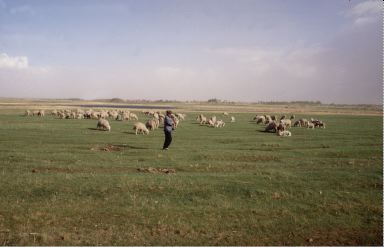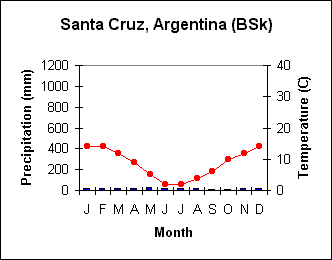9.5.3: Midlatitude Steppe
- Page ID
- 16100

The midlatitude steppe climate shares many of the same characteristics that the tropical steppe has. Both are semi-arid climates that are affected by their interior continental or leeward orographic position. However, the midlatitude steppe experiences larger temperature ranges and receives more total rainfall than the tropical steppe climate.
Geographic Distribution
Midlatitude steppes are found on the periphery of midlatitude deserts and the leeward side of mountain systems in inner Asia, South America, and the Western United States. Much of the Great Plains of the United States lies in the midlatitude steppe climate. Broad expanses of steppe climate run through Mongolia and Kazakhstan.
Controlling Factors
The controlling factors over the geographical distribution and climatic characteristics of the midlatitude steppe are similar to that of the midlatitude deserts. The climate is found in the interior of the vast midlatitudes continents of the Northern Hemisphere, far removed from sources of moisture. Midlatitude steppe climate is located in the rain shadow of tall mountain chains like the Rocky and Andes Mountains in North and South America respectfully. These mountain systems act as a barrier to westerly flowing moist air.
 |
Figure \(\PageIndex{2}\): Climograph for Hohot, China
Average Annual Temperature (C) = 6.1 |
Distinguishing Characteristics
Temperature
Temperature in the midlatitude steppe climate varies considerably with latitude, elevation, and continentality. Temperatures can range from -40oC (-40oF) in winter to above 40oC (104oF) in summer. Due to their continental position, the steppe climates of the northern Great Plains and Siberia generally experience the lowest temperatures of this climate. As one might expect, temperature increases as one travels toward the equatorward margin of the climate. Cooler temperatures also prevail as one moves toward high elevation. The temperature range for central Asian locations can be as much as 40oC (22oF), yet along the Argentine coast as small as 12oC (6.7oF). Though places like Santa Cruz, Argentina have a moderately small temperature range due to their near-coastal location, they lie in the rain shadow of the Andes and hence experience very little precipitation.
 |
Figure \(\PageIndex{3}\): Climograph for Santa Cruz, Argentina
Average Annual Temperature (C) = 8 |
Precipitation
With annual precipitation greater than half the annual potential evapotranspiration, the midlatitude steppe is considered a semi-arid climate. Precipitation ranges from 100 to over 300 mm in a year. There are few generalities that can be made about the precipitation regime of this climate. The seasonality of precipitation is similar to the nearest humid climate. Generally speaking, if the steppe climate borders the humid continental climate it is likely to have a summer maximum while bordering the humid subtropics a winter maximum may occur. Those steppe climates located closer to the coast may not have significant variability in their precipitation.


